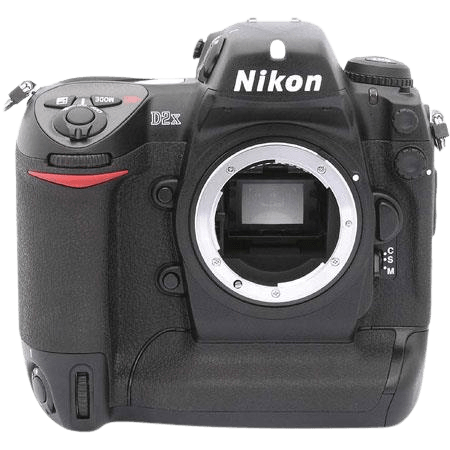Nikon D2Xs Specs and Scores

The Nikon D2Xs scores a 36/100 in our evaluation. Announced on June 1, 2006, this DSLR camera had a launch price of $4250. Measuring 158 x 150 x 86mm and weighing 1200g (2.65lbs), it is a hefty piece of equipment.
While the Nikon D2Xs was a competitive camera during its release year, it struggles to keep up with today’s market. Cameras have come a long way since 2006, and the D2Xs’ specifications no longer stand out among newer, more advanced options. However, it remains a reliable choice for those seeking a quality DSLR camera with a proven track record.
Nikon D2Xs Overview and Optics
The Nikon D2Xs receives a score of 43/100 for its optics. With 12.2 megapixels, an APS-C CMOS sensor, and Nikon’s image processing engine, the camera produces decent image quality. The sensor has a DXOMARK score of 59, which is average in today’s market. The camera’s shooting speed is 8 frames per second, allowing for fast action photography.
The Nikon D2Xs uses a Nikon F DX lens mount, which provides compatibility with a wide range of lenses. However, the absence of image stabilization can result in blurry images if not used with a stabilized lens or tripod. The camera’s aspect ratio is 3:2, which is standard for most DSLRs.
When considering the optics of the Nikon D2Xs, it is clear that the camera has a few strengths but also some limitations. While it may not compete with newer models, the camera still has decent specifications for those who prefer a more basic DSLR.
Nikon D2Xs Video Performance
The Nikon D2Xs lacks video functionality. However, it has built-in time-lapse capabilities.
Nikon D2Xs Features and Benefits
The Nikon D2Xs features score is 17/100, which shows that its specifications are not as competitive in today’s market. The camera’s screen size is 2.5 inches with a screen resolution of 235,000 dots. It lacks a touchscreen, flip screen, GPS, WIFI, and Bluetooth capabilities.
Compared to modern cameras, the Nikon D2Xs falls short in terms of features. Nowadays, photographers expect touchscreens, flip screens, and wireless connectivity options like GPS, WIFI, and Bluetooth for seamless photo sharing and navigation. The absence of these features limits the camera’s versatility and user experience.
The Nikon D2Xs may have been a solid choice during its release, but it struggles to compete with current camera models. Its low features score and the absence of essential modern specifications make it less appealing to photographers seeking advanced functionality and convenience.
Nikon D2Xs Storage and Battery
The Nikon D2Xs storage and battery score is 51/100. It has a single memory card slot that accepts Compact Flash (Type I or II) cards. In comparison to modern cameras with multiple card slots and SD card support, this storage capacity may seem limited. The D2Xs uses an EN-EL4a battery, which provides an impressive 2000 shots before needing a recharge. However, it lacks USB charging capabilities, which is a common feature in today’s market.
The Nikon D2Xs falls short in storage and charging options compared to contemporary cameras, yet its battery life still stands strong. Despite its limitations, the D2Xs remains a solid choice for those prioritizing battery performance.
